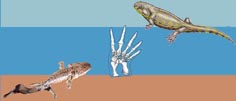Isotopic Framework
The Isotopic Framework covers three main themes; stratigraphy, palaeoenvironment (the ancient environment in which the fossils lived) and palaeoclimate.
We are using carbon isotope stratigraphy (changes in δ13C that can be correlated across different sections) to enhance the correlation of different sections, linking with the Palynological and Stratigraphic Frameworks.
The total organic carbon content (TOC), the specific carbon and bulk carbon isotope signature of sedimentary rocks are used to investigate the origin (marine or terrestrial) of plant matter contained within them. The isotope analyses is strongly linked with the Sedimentological Framework in order to provide a palaeoenvironmental context to the tetrapod fossils.
Data from oxygen and carbon stable isotopes (δ18O and δ13C) obtained from well-preserved shelly fossils such as ostracods can be used to interpret the palaeoenvironment, both in terms of salinity and water temperature. In local terms, this can tell us about the environment in which the tetrapods lived, for example, whether it was freshwater, brackish or marine. In global terms, we will identify geochemical evidence for the timing of the Devonian-Carboniferous ice age and when its different glacial stages occurred.

